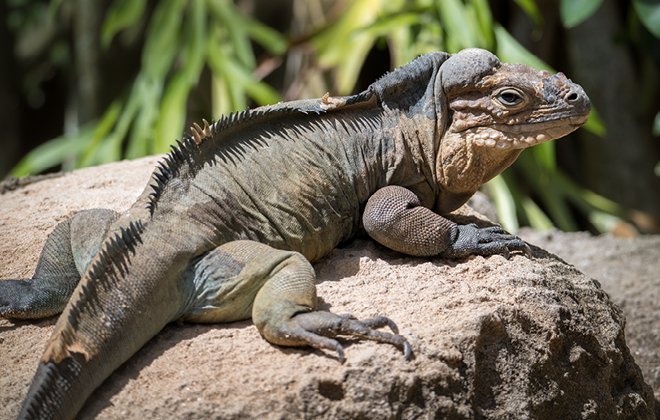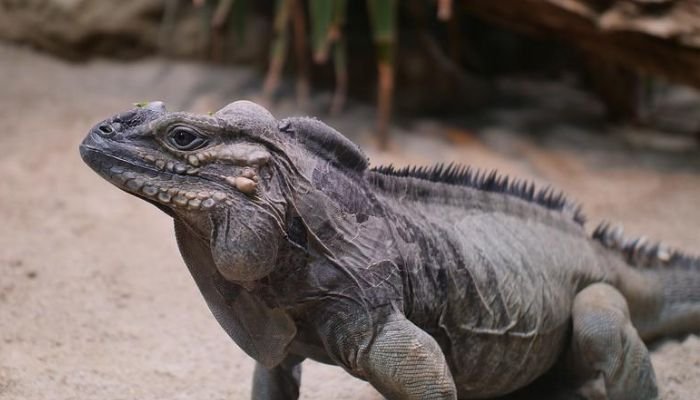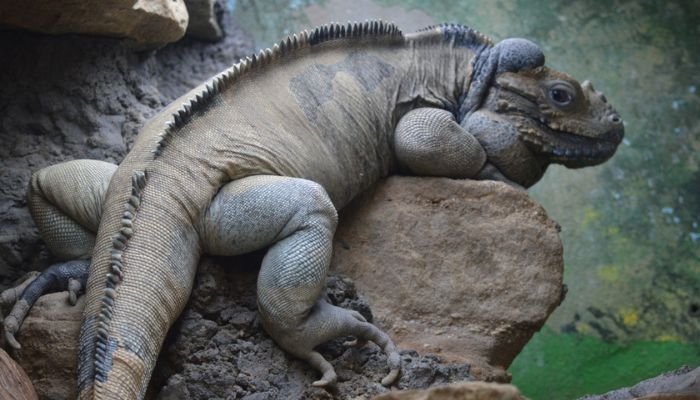
The gorgeous and distinctive Rhinoceros Iguana is native to the islands of the Caribbean. The Rhinoceros Iguana is easily identifiable due to its sturdy body, prominent horn-like structures on its cranium, and exquisite scale patterns. It primarily inhabits rocky topography and coastal areas, and its diet consists primarily of vegetation and infrequently of small crustaceans. The degradation of its habitat and illegal hunting have contributed to the rhinoceros iguana’s status as a vulnerable species. The objective of conservation efforts is to preserve the remaining habitats of the iguana and to promote public awareness of the importance of protecting this magnificent species.. Here are Rhinoceros iguana Guide on Food, Habitat, Size, Lifespan & Predators below-
Rhinoceros iguana Stats in Table format
The stats are given below for Rhinoceros iguana
| Reptiles List | Rhinoceros iguana |
|---|---|
| Family | Iguanidae |
| Type | Lizard |
| Size | Large |
| Length | Rhinoceros iguana: Up to 3-4.5 feet (0.9-1.4 meters) |
| Color | Rhinoceros iguana: Typically has a gray or brown coloration with darker markings. |
| Weight | Rhinoceros iguana: Adult rhinoceros iguanas can weigh between 10 to 20 pounds or more.. |
| Lifespan | 15-20 years (or more) |
| Reproduction | Oviparous, lays eggs |
| Gestation Periods | The gestation period for a Rhinoceros iguana is approximately 3 to 4 months. |
| Endangered Status | Vulnerable (IUCN Red List) |
| Features | Horn-like protrusion on snout, spiky appearance |
| Country & Areas | Dominican Republic, Haiti |
Rhinoceros iguana Natural Habitat and Distribution
The Rhinoceros iguana is native to the Caribbean islands of Haiti and the Dominican Republic, as well as a few of the smaller islands in the region. These reptiles like rocky and dry environments including coastal areas, scrub woods, and areas with a lot of limestone. They are skilled climbers and can frequently be seen warming themselves in the sun on rocks or branches.
Rhinoceros iguana Physical Features and Adaptations
Here are some information about Rhinoceros iguana
1. Body Structure
The body structure of a male Rhinoceros iguana is normally larger than that of a female. From head to tail, they can grow to an average of 76 to 137 centimeters (2.5 to 4.5 feet). Their bodies are covered in strong, rough scales that defend them well from predators and the elements. Their tail, which is lengthy and muscular, accounts for a sizable proportion of their total body length.
2. Coloration and Patterns
Rhinoceros iguanas exhibit sexual dimorphism in their patterning and coloring. Iguana juveniles are often a bright green, which helps them blend in with the surrounding flora. As they get older, they gradually fade to a muted grayish brown or dark gray. During the mating season, adult males may take on a ruddier appearance. These lizards are able to blend into their surroundings with the help of the dark bands or stripes that cover their body.
3. Defense Mechanisms
Rhinoceros iguanas have a number of defense strategies at their disposal to fend off danger. When threatened, they can use their powerful tails to strike back at their attackers. In addition, they have excellent climbing skills, which allow them to reach safer heights and avoid their predators. They are protected from bites and scrapes by their tough, bumpy scales.
Rhinoceros iguana Diet and Feeding Habits
Here are some information about Rhinoceros iguana
1. Diet Type
Rhinoceros iguanas are herbivores, getting the vast majority of their nutrition from plant stuff. They eat all sorts of plants that grow in their natural environment, including fruits, leaves, flowers, and other flora.
2. Preferred Food Sources
Rhinoceros iguanas get most of their nutrition from the plants and animals that grow naturally in their environment. Cacti, figs, and berries, as well as the leaves of various trees and bushes, are among their favorite foods. They will also eat young plants and flowers if they are available.

3. Feeding Schedule
Rhinoceros iguanas are diurnal, meaning they are more active during the day, and hence have a daytime feeding schedule. Early morning and late afternoon are prime feeding times for them, which generally coincides with daylight hours. They either scrounge around on the ground or ascend to higher branches and shrubs in search of their meal.
Rhinoceros iguana Housing and Enclosure Requirements
Here are some information about Rhinoceros iguana
1. Terrarium Size and Setup
Providing a healthy environment for a captive Rhinoceros iguana requires careful consideration of terrarium size and design. Because of their size, a big terrarium is required for these reptiles. For a single adult Rhinoceros iguana, a minimum enclosure size of 8 ft (2.4 m) in length, 4 ft (1.2 m) in width, and 6 ft (1.8 m) in height is recommended. It’s important to create an environment that’s as close as possible to their natural one, which means giving them plenty of places to climb and perch.
2. Substrate Options
The substrate in the terrarium should be selected with care, taking into account the iguana’s health and well-being. The iguana needs a substrate that allows it to dig and burrow, and this can be achieved by combining dirt, play sand, and coconut coir. The enclosure needs to be cleaned on a regular basis, and any visible dirt or debris should be removed.
3. Temperature and Lighting
Lighting and temperature gradients are also important for the thermoregulation of the Rhinoceros iguana. One end of the enclosure should be a warm basking zone of around 95°F (35°C), while the other should be a colder location of about 80°F (27°C). Ceramic heat emitters or basking lights can be used to provide the necessary conditions and maintain them.
Humidity and Water Needs
Rhinoceros iguanas prefer a moderately humid habitat, similar to that found in the Caribbean. You can get a similar effect by manually or automatically spraying the enclosure on a daily basis. They will have access to clean water for drinking and bathing whenever they need it if you provide a shallow water dish.
Rhinoceros iguana Behaviour and Temperament
Here are some information about Rhinoceros iguana Behaviour and Temperament
Activity Levels:
Rhinoceros iguanas are primarily active throughout the day because they are diurnal reptiles. To get their bodies ready for the day’s activities, they lounge around in the sun all morning. Both temperature and food availability affect their levels of activity. They may become less active and seek refuge in burrows or crevices in order to maintain a comfortable internal temperature during periods of excessive heat or cold. Maintaining their physical and emotional health in captivity relies on giving them plenty of room to roam and the option to climb and sun themselves.
Social Behavior:
Although rhinoceros iguanas prefer to spend their time alone, you may occasionally see them engaging in a variety of social behaviors. Males may become more possessive and aggressive during the breeding season. Outside of mating season, however, they are tolerant of other iguanas, especially in regions with plenty of food or places to bask. Iguanas’ personalities and the availability of resources influence how they interact with one another, which can range from violence to apathy.
Handling and Taming:
When first encountered in the wild, Rhinoceros iguanas are not used to interacting with humans and may become defensive or timid if handled. Therefore, they can be difficult to tame and handle, and care must be taken. It is crucial to give captive animals plenty of room to move around and places to hide in order to lessen their stress levels. Some people may grow up to be more accepting of humans if they are handled frequently and gently beginning in childhood. Bear in mind, however, that they are still wild animals and require special care to prevent stress or injury.
Rhinoceros iguana Breeding and Reproduction
Here are some information about Rhinoceros iguana Breeding and Reproduction
1. Mating and Courtship Rituals
Breeding occurs in the spring, and Rhinoceros iguanas engage in elaborate mating and courtship rituals at this time. In an effort to woo potential mates, males become more aggressive and perform complex courtship rituals. Some examples of such demonstrations include bobbing of the head, the extension of dewlaps (throat fans), and other shows of physical strength. The domain of a dominant man will be fiercely defended from any other males.
2. Incubation and Hatchlings
When a female is sexually receptive, she welcomes the attention of the alpha male and gives him the opportunity to mate with her. The female will search for an appropriate place to lay her eggs after a copulation that can take several minutes.
Rhinoceros iguana Common Health Issues and Veterinary Care
Here are some information about Rhinoceros iguana Common Health Issues and Veterinary Care
1. Respiratory Infections
Rhinoceros iguanas, especially those kept in captivity where conditions are not ideal, are prone to contracting respiratory illnesses. Inadequate ventilation, poor humidity control, or exposure to cold gusts are common culprits in the spread of many illnesses. Wheezing, difficulty breathing, nasal discharge, and fatigue are all signs of a respiratory infection. In order to diagnose and treat respiratory infections quickly, immediate veterinary attention is essential.
2. Parasites
Rhinoceros iguanas are susceptible to parasites, both internal and external, which can compromise their health. Nematodes and coccidia are examples of common internal parasites, while ticks and mites are examples of common external parasites. Parasite infections can be avoided with preventative measures including having your vet check the feces of your pets regularly and keeping their enclosure clean. If parasites are found, treatment and deworming should be carried out under veterinary supervision.
3. Metabolic Bone Disease
Metabolic bone disease (MBD) affects many captive reptiles, including Rhinoceros iguanas, and is a serious problem in the industry. Deficiencies in calcium, phosphorus, and vitamin D3 in the diet cause this condition. A lack of exposure to UVB lighting is another possible cause of MBD. Deformities and fractures might occur as a result of the weakened bones caused by this illness. Preventing MBD requires a healthy diet, adequate UVB lighting, and calcium supplementation.

Importance of Regular Vet Check-ups
Rhinoceros iguanas in captivity require routine veterinary care to ensure their survival. The veterinarian can evaluate the lizard’s overall health, spot potential problems early, and prescribe the best course of action for preventing future illnesses in this way. Vet visits for Rhinoceros iguanas typically consist of a physical exam, fecal exam for parasite screening, and evaluation of the iguana’s diet and living conditions.
The health and happiness of the iguana can be ensured with the help of veterinarians who have experience caring for reptiles in terms of diet, cage setup, and environmental conditions. Changes in behavior or appearance might be another warning sign of illness, so it’s important to get checkups often.
Conclusion:
The Rhinoceros iguana is an extraordinary lizard because of its unusual characteristics and fascinating mating habits. It is essential for their survival in the wild or in captivity that their behavior, breeding, and health needs be understood. We can aid in maintaining the health and lifespan of these remarkable creatures by giving them appropriate housing, a nutritious diet, and timely veterinarian attention. It is our responsibility as guardians of the planet’s biodiversity to ensure this species’ survival and expansion.
FAQs
Q: What is the family and Type of a Rhinoceros iguana?
The Rhinoceros iguana is a lizard of the genus Iguana and the family Iguanidae. Cyclura cornuta is the scientific name for the Rhinoceros iguana. The Rhinoceros iguana is a huge and stunning lizard that is exclusive to the Caribbean islands. It gets its name from the horn-like growth on the end of its snout.
Q: What is the average size of a Rhinoceros iguana?
Rhinoceros iguanas reach a maximum length of between 2.5 and 4.5 feet (0.76 and 1.37 meters) in length, with males normally being larger than females.
Q: How long can a Rhinoceros iguana grow in size and length?
Rhinoceros iguanas, when fully grown, can measure between 4.5 and 5.5 feet in length, or 1.37 to 1.68 meters.
Q: What colors do Rhinoceros iguanas come in?
Although typically gray, rhinoceros iguanas can occasionally be found with dark green or brown tones and the occasional black patch. It’s possible that younger people simply have a more vivid perception of color.
Q: How big can a Rhinoceros iguana get in weight?
The average weight of a healthy adult rhinoceros iguana is 10–20 pounds (4.5–9 kg).
Q: How long do Rhinoceros iguanas live?
Rhinoceros iguanas typically only survive for 10–20 years in the wild, but can live for 40 years or more in captivity.
Q: How do Rhinoceros iguanas give birth?
Rhinoceros iguanas, like most other reptiles, hatch their offspring from eggs. After mating, the female digs a hole in the ground or digs a nest in the sand. After 85-100 days in the incubator, the eggs hatch into young.
Q: How long is the gestation period for a Rhinoceros iguana?
There is no such thing as a gestation period for Rhinoceros iguanas because they lay eggs rather than carrying them to term. The time it takes for eggs to mature and hatch after being laid is called the incubation period.
Q: Is the Rhinoceros iguana endangered?
The Rhinoceros iguana (Cyclura cornuta) is listed as a vulnerable species by the International Union for the Conservation of Nature. Human activities such as habitat destruction and poaching also pose a threat.
Q: What are the prey of Rhinoceros iguanas?
The leaves, fruits, and flowers of plants make up the vast majority of a rhinoceros iguana’s food.
Q: Do Rhinoceros iguanas have any predators?
Adult Rhinoceros iguanas have few natural predators because of their size and spiky appearance. However, birds of prey and other carnivorous species may find young iguanas easy pickings.
Q: How Fast Does Rhinoceros iguanas Move?
Unfortunately, rhinoceros iguanas can’t be considered fast runners. They’re better suited for climbing than moving quickly on the ground.
Q: What is the Bite Force of a Rhinoceros iguana in PSI?
I don’t know the Rhinoceros iguana’s bite strength in pounds per square inch (PSI). In comparison to larger predators, their bite strength is typically considered to be subpar.
Q: Can we keep Rhinoceros iguanas as pets?
Rhinoceros iguanas are not a good choice of pet for the vast majority of people. They require special care, a spacious enclosure, the appropriate diet, and spotless living conditions. Some places may prohibit or severely restrict ownership as pets because of their endangered status.
Q: Are Rhinoceros iguanas venomous?
No, Rhinoceros iguanas are not poisonous, as the question implies. They don’t have venom glands or fangs.
Q: Are Rhinoceros iguanas good for pest control?
Since they don’t eat any insects, rhinoceros iguanas don’t help keep bug populations in check. They are primarily plant eaters and only eat meat sometimes.
Q: Do Rhinoceros iguanas require a UVB light source?
Like many other reptiles, rhinoceros iguanas require UVB sunshine for proper calcium metabolism and good health. The body produces vitamin D3 in reaction to UVB sunshine, which aids in calcium absorption and contributes to healthy bones. Iguanas kept as pets must have constant access to UVB lighting.
I hope you like reading on Rhinoceros iguana FAQ Guide on Food, Habitat, Size, Lifespan and Predators.
